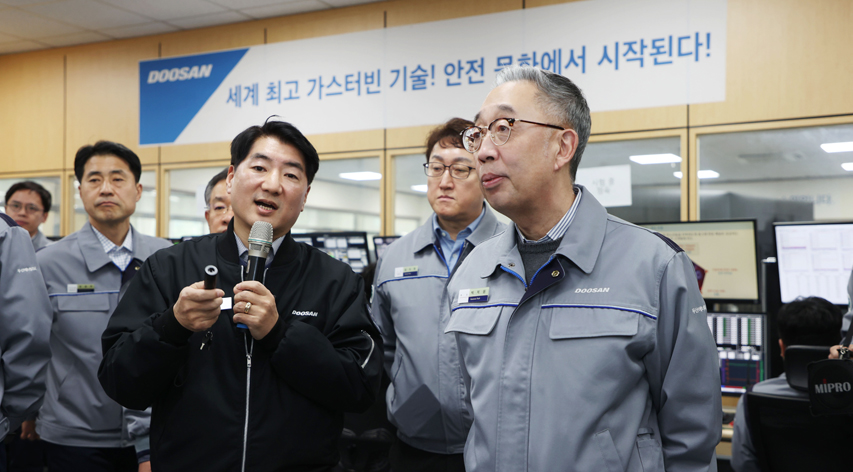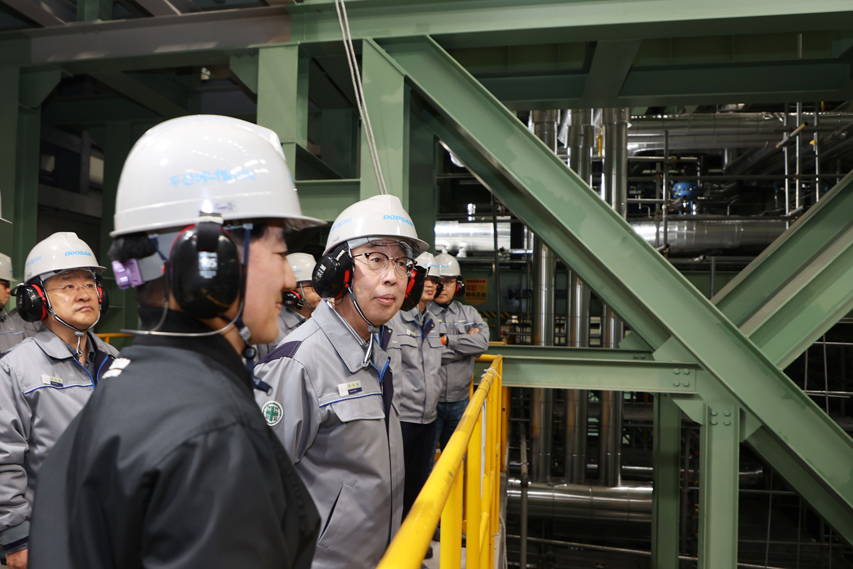“Buoyed by the confidence won from successfully developing a K-gas turbine, we aim to become the global leader of hydrogen turbines.”
On March 7th, Doosan Enerbility announced that Doosan’s leadership, including Geewon Park, Chairman & CEO of Doosan Enerbility; Seungwoo Sohn, Head of Doosan Enerbility’s Power Services Business Group; Dowon Kim, Chief Strategy Officer of Doosan Corporation and Minchul Kim, Chief Financial Officer of Doosan Corporation, had paid a visit to the gas turbine/ hydrogen turbine manufacturing shop at the Changwon headquarters. With plans in place to earnestly pursue growth of the gas turbine order intake, the visit was made to offer encouragement to the employees there and to inspect the status of the hydrogen gas turbine development work which is well underway.
In 2019, Doosan Enerbility became the fifth in the world to successfully complete development of a large-size* gas turbine for power generation, which was a project that had been initiated in 2013. Since then, Doosan’s first gas turbine, which had been delivered to the Gimpo Combined Heat & Power Plant, successfully went into commercial operation in July of last year, leading to the securing of product credibility. Based on this track record, Doosan was able to successively win a number of new orders, such as the gas turbine supplier contract for the Boryeong New Combined Cycle Power Plant in 2023 and the Andong Combined Cycle Power Plant in 2024. Doosan Enerbility plans to pick up the pace for this area of business, as the company’s goal is to achieve an order intake of KRW 7 trillion or more in the Korean domestic market over the next five years.* Gas turbines can be categorized by its generation capacity into small-size (20~99.9MW), mid-size (100~214.9MW), large-size (215~299.9MW) and ultra-large (300MW+) turbines (Source: McCoy Report
The company is also stepping up efforts in the area of hydrogen turbine development using its gas turbine technology. Doosan is currently involved in the development of a high-efficiency 50% hydrogen co-fired H-class* gas turbine, which is a state project that has been led by the Ministry of Trade, Industry and Energy since 2020. A demonstration project of the developed technology is to be carried out at Korea East-West Power Co.’s Ulsan Combined Cycle Power Plant. Work is also underway to develop the world’s first ultra-large 400MW 100% hydrogen-fueled gas turbine by 2027. Compared to the existing hydrogen turbines (E-class), the H-class hydrogen turbine provides the benefits of fuel cost savings amounting to approximately KRW 46 billion per year and additional carbon emissions reduction** of approximately 50 thousand tons per year.* High-efficiency turbine that is made out of superalloy and is designed to withstand high temperatures going up to 1500℃ or higher** Assumption is that it is for a 400MW 50% hydrogen co-fired power plant, with an annual operating rate of 50% and that the KOGAS average rates and hydrogen prices as of Feb. 2024 are applied.
“Our focus this year will be on increasing the order intake for our K-gas turbine, which was jointly developed by some 340 players in the Korean domestic industry, academia and research sectors,” said Geewon Park, Chairman and CEO of Doosan Enerbility. “Backed by our technical expertise and confidence won from our successful gas turbine development, we aim to solidify our position as the global leader of hydrogen gas turbines, which is gaining attention these days as a high-efficiency, carbon-free power generation technology.”
According to the 10th Basic Plan for Long-Term Electricity Supply and Demand released by the South Korean government last year, the LNG-fired power generation capacity is forecast to increase from 45.3GW in 2024 to 64.6GW by 2036. As for hydrogen-fueled power generation, by applying the 50% hydrogen co-firing technology, plans are in place to swiftly increase the generation capacity to 6.1TWh by 2030 and 26.5TWh by 2036.

